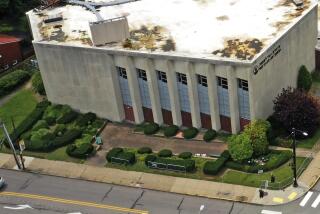TWA 800 Families Create Fund for Crash Victims
- Share via
RONKONKOMA, N.Y. — On the second anniversary of the explosion that killed the 230 people aboard TWA Flight 800, relatives established a fund Friday to help victims of air crashes past and future.
The Family Assistance Foundation, which they hope will be bankrolled mostly by the airline industry, would “protect the people who have become victims and who we know in our hearts in the future will become victims,” said Frank Carven, who lost a sister and a nephew in the disaster.
Carven, of Belair, Md., said at a news conference that the fund could take care of such needs as a child’s education or a mortgage payment after a breadwinner is lost in a plane crash.
The Salvation Army and the National Transportation Safety Board have agreed to serve with victims’ relatives as directors of the fund, and a Long Island Kiwanis group has made the first donation, he said. TWA and Boeing Co. are considering donations, and other airlines, pilots, flight attendants and mechanics will be approached, Carven said.
The relatives group, the TWA Flight 800 Assn., also announced plans to erect a permanent memorial to the victims and declared support for a change in federal law to remove limits on what relatives can recover in lawsuits.
The news conference began a weekend of commemoration that included a memorial service Friday evening at Smith Point Park, the beach closest to the spot where the plane went down.
Some of the relatives are raising separate funds to build a permanent monument at the park, where a temporary black stone monument was set up for the anniversaries this year and last year.
Some relatives will revisit the hangar at Calverton, where the jetliner’s reconstructed shell stands, and some will revisit the Coast Guard station where body after body was taken in the days after the blast.
A service also was planned at a local church.
Some things have changed in two years: The Federal Aviation Administration is studying ways to make aircraft fuel tanks safer. And Kathy and William Rogers, who lost a daughter in the explosion, have a 4-month-old baby girl.
One thing hasn’t changed though: The cause of the disaster remains unknown.
Late last year the FBI stepped out of the investigation, saying it had no evidence that a criminal act, such as a bomb or missile, destroyed the Paris-bound jetliner. That left mechanical failure, a theory embraced by the NTSB.
In public hearings in December, the NTSB said it was sure an explosion had occurred in the Boeing 747’s center fuel tank, but did not know what triggered it.
The FAA has issued a string of directives on fuel tanks and wiring. It is studying fuel flammability, tank safety and aging aircraft.
The Rogers family, of Montoursville, Pa., weren’t at the commemoration because they were too busy with baby daughter Kelsey Marie. But they will reminisce about their other daughter, Kimberly Marie, one of 16 Montoursville students who died, along with five chaperons.
James K. Kallstrom, the assistant FBI director who ran the criminal investigation of the blast, has retired to work for a Delaware bank.
TWA, which had just emerged from bankruptcy when the crash took place, is continuing a corporate refurbishment. It includes new color schemes and a fleet that will be 40% new by the end of 1999. An official said the overhaul began months before the crash and was not a response to it.
TWA’s daily New York-Paris trip is now called Flight 924.
More to Read
Sign up for Essential California
The most important California stories and recommendations in your inbox every morning.
You may occasionally receive promotional content from the Los Angeles Times.













